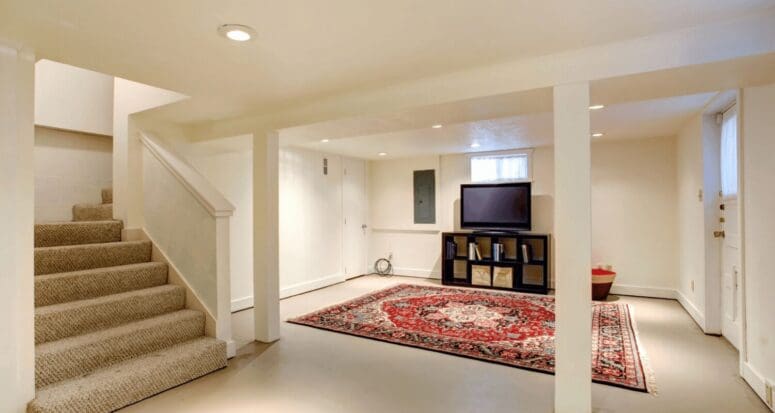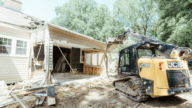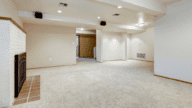A Finished Basement Adds Value to Your Home, Just Not In the Way You Think
- Published on
- 5 min read
-
 Emma Diehl, Contributing AuthorClose
Emma Diehl, Contributing AuthorClose Emma Diehl Contributing Author
Emma Diehl Contributing AuthorEmma's work has been featured in Huffington Post, NPR and XOJane. When she's not combing her neighborhood for open houses, she's writing about technology, real estate or data.
-
 Sam Dadofalza, Associate EditorClose
Sam Dadofalza, Associate EditorClose Sam Dadofalza Associate Editor
Sam Dadofalza Associate EditorSam Dadofalza is an associate editor at HomeLight, where she crafts insightful stories to guide homebuyers and sellers through the intricacies of real estate transactions. She has previously contributed to digital marketing firms and online business publications, honing her skills in creating engaging and informative content.
Your slab-of-concrete basement serves no real purpose but to collect dust and cobwebs at the moment. You dream of making it into a bright, cozy, and comfortable space you could use for just about anything. With so much room to work with, this blank canvas practically oozes potential — and presumably money, too, when the time comes to sell your home. But how much value does a finished basement add to a house?
“It’s tough to have that conversation around basement value because sellers can get mad when they find out that square footage doesn’t double the value of their home,” says Dan Jones, a Charlotte-based real estate agent who’s sold over 78% more properties than the average agent in his area.
Contrary to popular belief, you can’t count your finished basement square footage like you would a room addition upstairs. However, you might opt to finish it for other reasons. Here’s what you need to know to make a decision either way.
What the data says about finished basement returns on investment (ROI)
According to Angi, finishing a basement can be a significant investment, but it also adds value to your home, with a return of up to 70%. In simple terms, for every $1,000 you spend on the project, you could see around $700 added back to your home’s value.
That assumes your basement refinish includes exterior wall insulation, painted drywall for the walls and ceilings, painted trim, tile flooring (the works, but nothing overly luxurious), as well as a bar, bathroom, and main area.
How home appraisers factor a finished basement into their calculations
A home with a finished basement will be appraised for more than a home without, but based on the style of your basement, the value add will vary, explains Chuck Argianas, a Chicago-area appraiser with over 30 years of experience.
As a general rule, the deeper your basement is below-grade, the less the added square footage will appraise for. If your appraiser is going by Fannie Mae’s rule book, they won’t include your basement in the total square footage at all.
Most finished basements will fall into one of the following categories:
- Full basement or usable lower-level space: A full basement has ceilings tall enough for someone to stand up in and is often as large as the footprint of the home. Sometimes called usable lower-level space, these basements don’t have access to the outside unless through a set of stairs to ground level.
- English basement or walkout basement: An English basement is either fully or partially above ground and typically includes a separate entrance, often at the back, that allows you to literally “walk out” of the space. These basements are often more valuable per square foot since there’s a point of egress.
A basement remodel is usually more affordable than building an above-ground addition, making it a cost-effective way to create usable, heated living space.
According to Angi, finishing a basement costs about $32,000 on average, with prices ranging from $2,800 to $100,000 depending on materials, labor, permits, and extras like appliances or décor. In comparison, building a room addition is typically more expensive, averaging $48,000, with a price range of $7,000 to $125,000 based on similar factors such as materials, labor, and the type of room.
Costs for both projects can also vary by location and whether you hire a contractor or take on some of the work yourself. But overall, basement finishing tends to be a more budget-friendly way to add livable space.
However, no matter the condition or level below ground, the finished basement space will never equate to the same value as above-ground living space in the eyes of an appraiser.
“Appraisers will take a baseline, say, of $100 a square foot for the above-grade space. And maybe the below-grade space is 70% or $70. [While] appraisers recognize the value [of] the below-grade […] usable space, it won’t be at the same value [as above-grade space],” says Argianas.
The value at which an appraiser calculates your below-grade space will depend on a few factors, including its access to the outside (or lack thereof), total number of windows, the quality of finishes, and more.
In addition, appraisers will use comparables in your area to ballpark the value of your basement and property overall. To complicate things further, appraisals and definitions of a basement can also vary by location.
What factors will affect ROI?
Finishing your basement will certainly add some kind of value to your home, but just how much of that money you get back depends on a number of variables, including:
- Your real estate market.
Depending on where you live, your finished basement could be worth more in the long run. In cities like Washington, D.C., and Boston, finished basements are common, and square footage is at a premium. Being in a competitive market where the basement is common will likely increase its ROI. - Your material selection.
Refrain from remodeling your basement with top-of-the-line furnishings and finishes, Argianas says. “If you do finish a basement, modest is good, average is good. But, you don’t want to finish it out to the same level that you would the upper-level space.” By using middle-of-the-road but dependable fixtures and materials, rather than splurging on over-the-top items, you’ll save money upfront and see a higher ROI. - Use potential.
A finished basement that features a few open, spacious areas typically offers a better ROI than one divided into many small, closed rooms. Since basements often lack natural light, designing an open and adaptable layout is key to making the space more attractive and valuable.
To better determine how much value a finished basement might add in a future sale, work with a real estate agent well-versed in your market and comfortable with assessment practices in your area.
How to boost the ROI of your finished basement
Follow these five pro tips to get the most out of your basement budget:
1. Deal with radon upfront
Before you start building out a basement, spend the time and money necessary to test for radon. Radon is often found in basements because it’s a natural gas that comes up from the ground and tends to build up in low, enclosed spaces. Testing the space can give you and future buyers of your home peace of mind.
A professional test can run anywhere between $100 and $1,200 and will give you the information you need to move forward.
Radon mitigation projects, which will vary based on your home’s construction, design, and your local climate, make it possible to still finish out the basement as planned. On average, mitigation costs between $776 and $1,274, based on the method you go with.
2. Use hard materials for flooring
Even with the best of renovations, a basement is still a basement. Most buyers will see it as a “bonus” space, not a must-have in a home. High-end flooring isn’t necessary for the area, and can even backfire. “Don’t forget basements flood,” says Argianas.
Hardwood flooring is expensive, and using it in the basement can lead to warping from moisture naturally seeping through the ground. Similarly, carpeting in a basement can lead to musky scents and odors—a turnoff for buyers.
Instead, use ceramic, porcelain, or stone tile over cement board with accent rugs across the room. The right hard flooring will keep moisture at bay and renovation costs down.
3. Install recessed lighting and highlight exposed ceilings
Combat the lack of natural light in your basement by installing plenty of recessed lighting throughout the space. High-quality LED lights can be discreetly installed under cabinets and flush to the ceiling.
If a drop ceiling leaves your basement feeling dark or cramped, opt for an open, industrial look. You can leave ducts, beams, and wiring exposed. Paint them a bright white to make the room look bigger.
4. Make the garden-level entry welcoming
In the basement, natural light and access to the outside are in high demand. If you have an English or walkout level basement, highlight the feature with glass double doors and a small patio space.
Choose durable double doors with thick panes that insulate the space, and steel that can withstand the elements and provide security. Emphasizing outside access in an otherwise underground basement can make the space feel much bigger.
As for the patio: “I wouldn’t put down wood, because critters climb underneath there,” Argianas says. “Just pour a nice concrete pad and plant some flowers and a little garden.” Simple concrete slabs can cost $6 per square foot, and they don’t require much upkeep.
5. Create a mini in-law suite
Gone are the days of the basement den, says Jones. “The in-law suite, that’s in really high demand here.” With rising living costs, many families are turning to multi-generational living, bringing multiple generations under one roof to share expenses and support one another.
Often, in-law suites are defined as an accessory dwelling unit separated from the house, with a bedroom, bathroom, and small kitchen. With a big enough space and walkout access, however, homeowners can create a mini in-law suite in their basement. Because it’s not an additional unit on the property, you likely won’t be required to go through the rigorous permitting that traditional in-law suites require.
To maximize ROI in your finished basement, Jones recommends “adding at least one bedroom and bath while keeping everything as open as possible.” The open space will give buyers the ability to envision themselves there, but adding a bathroom and bedroom can raise the value of the below-ground square footage.
Then, depending on the budget, add a kitchenette, or at least hookups for one. “So wherever your drain is close to the bathroom, I would have a drain, a little dishwasher, countertop, maybe a little oven because more people are looking for that in-law suite,” Jones recommends.
Adding an in-law suite or a potential in-law suite can add value to a home for buyers as a place for guests, an Airbnb rental, or a private dwelling for an aging family member.
Top features that boost a basement’s appeal
When finishing a basement, certain features can significantly increase its appeal to potential buyers. Focusing on these key upgrades will help you create a functional, attractive space that stands out in the market.
- Functional amenities: Adding amenities, like wet bars, home theaters, or gyms, turns a basement into a fun and useful space. These extras make the space feel more livable and enjoyable for whatever you want to do.
- Natural light and windows: Basements that get lots of natural light through well-placed windows or light wells feel brighter and bigger. That open, airy vibe makes the space more welcoming and adds to its overall value.
- Open floor plans: An open layout makes the space versatile, perfect for family hangouts, a home office, or a workout area. This flexible design adapts easily to whatever your lifestyle demands.
- Built-in storage solutions: Adding built-in shelves, closets, or cabinets makes the most of your space and keeps the basement tidy. Good storage options are a popular feature that buyers appreciate and add real value to your home.
- Self-contained living area: Creating a separate living space with its own entrance, kitchenette, or bathroom can significantly boost a basement’s value. This setup appeals to buyers interested in rental opportunities or multigenerational living arrangements.
From start to ‘finished’ basement
It can be tricky to determine exactly how much value a finished basement will add to your home at resale, but with the right execution, finishes, and design choices, you can expect around 70% ROI. A finished basement won’t always add “official” square footage to your home, but it can add value to future buyers.
Just remember: Don’t assume that the value of improvements to below-ground space will be equal to the value of above-ground projects, and you won’t set unrealistic expectations for a project you’re sure to otherwise enjoy.
If you’re curious how much your home is worth, whether you’ve finished the basement or are still planning your project, HomeLight’s free home value estimator can give you a real-time estimate based on market data. It’s a quick and easy way to understand how improvements could impact your home’s resale value. Use the Home Value Estimator to get a fast, ballpark idea of your home’s worth.
Header Image Source: (Artazum/ Shutterstock)








